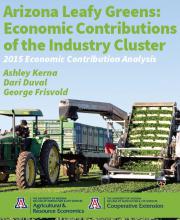Arizona Leafy Greens: Economic Contributions of the Industry Cluster

Leafy greens, a broad term used to describe vegetable crops with edible leaves, are an important crop group in Arizona. Arizona plays a key role in the country’s production of leafy greens, particularly lettuce varieties and spinach. Together, Arizona and California account for nearly 90% of all leafy greens produced (by weight) in the United States. In winter months, leafy greens are sourced almost exclusively from Arizona and California counties straddling the Colorado River. Considering the state’s role in national production, leafy greens are also an important part of Arizona’s agricultural economy. Since 2010, the state’s major leafy green commodities (lettuce, spinach, and cabbage) have accounted for approximately one-fifth of all agricultural sales (crops and livestock) in Arizona and have represented a large majority of vegetable and melon sales.
Sales of leafy greens contribute to the state economy, providing incomes and jobs for people working on Arizona farms. These contributions to the state economy, however, are not limited to on-farm activities. They extend to an entire cluster of industries that are involved in essential post-harvest activities that ensure the quality and shelf life of leafy greens products. The leafy greens industry cluster, therefore, includes farms producing leafy greens as well as post-harvest industries such as refrigerated warehousing, transportation, and wholesale services. Using estimates for 2015 and the IMPLAN software, the total economic contribution (including indirect and induced multiplier effects) of the leafy greens industry cluster to the state economy was estimated. . Results reported include sales (output), value added (synonymous with Gross State Product [GSP]), incomes, and state and local tax revenues. With limited data, we also estimate employment supported by Arizona’s leafy greens industry cluster.

